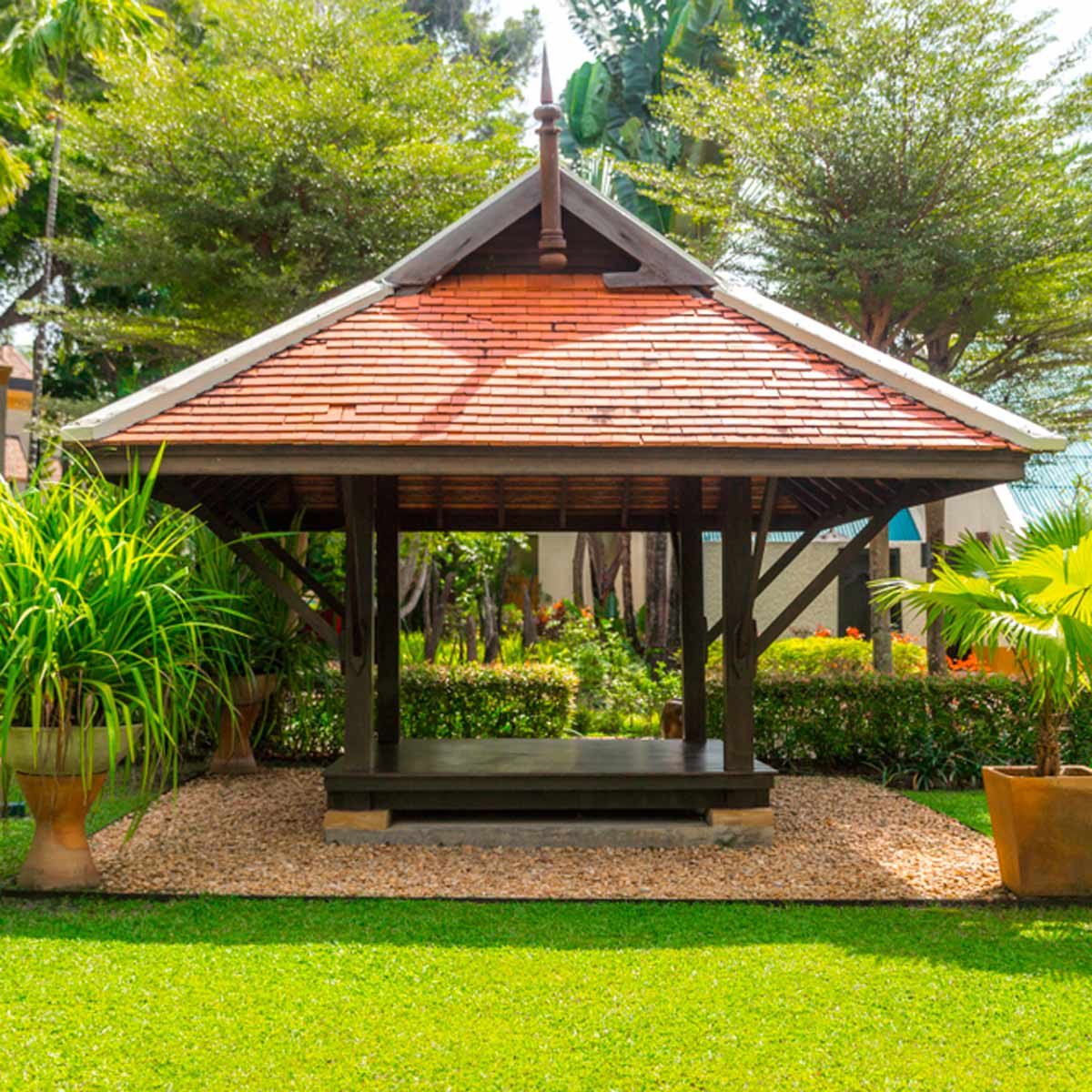Offering shelter, shade and refuge, gazebos beckon you to spend more time outdoors. Learn more about this valued garden structure.

What to Know About Gazebos

A gazebo offers an excuse to be in the garden no matter what the weather. A convenient roof keeps off the rain, yet wide open expanses allow cooling breezes. What better spot than a gazebo to enjoy your backyard?
On This Page
What Is a Gazebo?
A gazebo is a covered outdoor structure, usually freestanding, that is open on all sides. A gazebo differs from a pergola in one important way: A gazebo has a covered roof for full protection from sun and rain, while a pergola is slatted, offering only partial coverage. And while a gazebo is a garden destination, a pergola is more often a vine-covered garden accessory placed along a pathway.
Both can be a destination on a pleasant day, but a gazebo offers more protection from the elements. Some gazebos are attached to a house and open on just three sides.
Types of Gazebos
Gazebos are permanent or portable. Permanent gazebos are garden structures set in place for the long term. Usually made of wood, plastic or composite materials, they have a shingle, shake or metal roof with a floor, and are anchored in place to withstand wind and weather.
Portable gazebos usually feature metal poles, open sides and a fabric roof, but no floor. They are often set over a grill or patio to offer rain protection, and can be set up or taken down easily.
Pros and Cons of Gazebos
Gazebos provide a lot of value for the money. Permanent gazebos are handsome and a definite asset to the garden. However, they are the most expensive, ranging from $3,500 to nearly $10,000. The price can go higher when adding accessories such as a cupola, tiered roof and screening.
Portable gazebos can cost as little as $400, but they’re also not as attractive as permanent gazebos. However, they are practical, offering rainy day protection for grilling, outdoor entertaining or simply hanging out.
Style and Size
There’s a style and size gazebo for every backyard. Styles range from traditional Victorian to rustic to modern. And gazebos are sized for anything from a card game to a lavish dinner party. Commercial gazebos are even bigger, with the intent of hosting weddings and parties. Don’t forget to check out our favorite backyard gazebo ideas for summer.
Consider running electricity to the gazebo and installing lighting and a ceiling fan. Both will contribute greatly to the gazebo’s use, especially in muggy weather and at night.
Location
When deciding where to place a gazebo, walk around your property and look back toward the house. Find an accessible spot with a vantage point that is equally attractive from the house and the gazebo. Don’t worry if you have a tiny yard. You can choose a small gazebo or even a pop-up portable gazebo. Both will provide a focal point for the yard and a sense of destination. Be sure to check out local zoning regulations, as a permit will be necessary for permanent structures.
Installation
A portable gazebo can be placed anywhere if staked securely in place. A permanent gazebo will require a foundation — concrete piers or a concrete slab.
Once a foundation is in place and approved by inspectors, the gazebo can be erected. It will consist of posts, beams, rafters and a roof. A square roof is simplest to install, while the more traditional hexagonal or octagonal roof requires more effort. Some gazebo kits come with a two-tiered roof and cupola, requiring extra steps. Railing, sometimes called knee walls, is a good option. Railing panels are not only decorative, they direct foot traffic to the entrance and prevent stumbles off the gazebo floor.
Maintenance
Maintenance depends on the construction materials. Plastic and composite require only periodic sweeping and an annual cleaning. Use warm water, mild soap and a soft-bristle brush, then rinse with a hose. Wooden structures also require cleaning, as well as painting, staining or treatment with a clear waterproof seal.



















